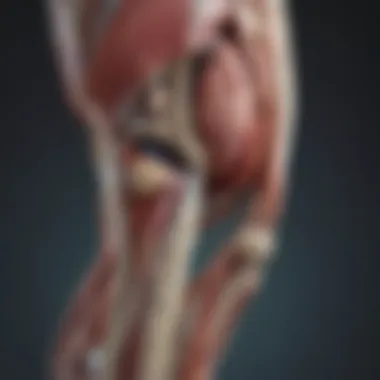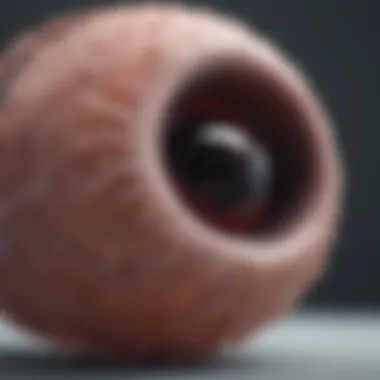Stem Cells and ACL Repair: Innovations in Healing


Intro
The anterior cruciate ligament (ACL) is vital for knee function and stability. Injuries to this ligament are common, particularly in athletes. Traditional repair methods can be effective, but they may not fully restore the ligament's natural function or expedite healing. Recently, there has been growing interest in stem cell therapy as a potential alternative or adjunct to conventional treatments. The unique properties of stem cells offer exciting possibilities for enhancing ACL repair processes.
Understanding how stem cells can impact ACL injury recovery is essential for both clinical and research communities. This narrative aims to unpack the underlying biology of stem cells, their application in ACL repair, and the implications for future medical practices.
Key Concepts and Terminology
Definition of Key Terms
- Stem Cells: Undifferentiated cells capable of differentiating into specialized cell types. They can self-replicate and have the potential to aid in tissue repair.
- Anterior Cruciate Ligament: A critical ligament located in the knee that connects the femur to the tibia, playing a key role in joint stability and movement.
- Regenerative Medicine: A branch of medicine focused on repairing, replacing, or regenerating damaged tissues and organs using various technologies, including stem cells.
Concepts Explored in the Article
This article explores several concepts regarding the intersection of stem cell therapy and ACL repair:
- The biological mechanisms by which stem cells facilitate injury recovery and tissue regeneration.
- Current methodologies for applying stem cells in ACL treatment, including sources of stem cells and delivery techniques.
- The potential advantages and challenges of integrating stem cell therapy within existing treatment protocols.
- Future research directions that could further elucidate the roles of stem cells in orthopedic medicine.
Findings and Discussion
Main Findings
Research indicates that stem cells can accelerate the healing process of the ACL by promoting cell proliferation, tissue regeneration, and collagen synthesis. These cells can be derived from various sources, including:
- Bone marrow
- Adipose tissue
- Synovial fluid
Each source has distinct characteristics that can impact the effectiveness of therapy. Additionally, methods such as injection, surgical implantation, and culture expansion are critical in determining how stem cells are used in practice.
Potential Areas for Future Research
Despite the promising findings, challenges remain in stem cell therapy for ACL injuries. These include ethical considerations, potential adverse effects, and the variability in outcomes based on cell sources.
Future research should focus on:
- Exploring optimal sources and types of stem cells for ACL repair.
- Longitudinal studies to assess long-term outcomes of stem cell-based treatments.
- Developing standardized treatment protocols to enhance the reliability of results.
Stem cell therapy has the potential to reshape the landscape of ACL repair, addressing both the biological aspects of healing and the clinical complexities involved.
As our understanding of stem cells continues to grow, the prospect of improving ACL recovery becomes increasingly feasible.
Prelude to ACL Injuries
The anterior cruciate ligament (ACL) plays a crucial role in maintaining the stability of the knee joint. Understanding ACL injuries is fundamental for developing effective treatments, particularly when exploring advanced options like stem cell therapy. ACL injuries are common, especially among athletes. The significance of this topic cannot be overstated as it impacts both physical performance and overall quality of life.
Injuries to the ACL commonly occur during sports that involve sudden stops or changes in direction, such as soccer, basketball, or skiing. By delving into this aspect, we can gain insight into not only the prevalence of these injuries but also the biological implications of ACL damage.
Prevalence and Causes of ACL Injuries
ACL injuries are prevalent in various demographics, particularly among young individuals engaged in sports. Statistics suggest that approximately 200,000 ACL injuries occur each year in the United States alone. Sports-related incidents account for a significant portion of these injuries. Factors contributing to ACL injuries include:
- Biomechanical factors: Poor technique, improper footwear, and surface conditions can increase susceptibility.
- Anatomical factors: Gender differences influence injury rates; for instance, females generally have a higher incidence compared to males, possibly due to anatomical and hormonal factors.
- Neuromuscular control: Players with poor strength or coordination may be more likely to suffer an ACL tear.


Understanding these factors is essential for prevention strategies and treatment modalities, especially in constructing an effective rehabilitation plan.
Current Treatment Options for ACL Injuries
When an ACL injury occurs, the immediate treatment often involves conservative measures like rest, ice, compression, and elevation (RICE). However, the severity of the injury can necessitate surgical intervention. The most conventional approach to ACL repair involves:
- ACL Reconstruction: This surgical procedure replaces the torn ligament with a graft taken from the patient’s own body (autograft) or a donor (allograft).
- Physical Therapy: Post-surgical rehabilitation focuses on restoring range of motion, strength, and functional stability. Customized rehabilitation protocols help patients recover efficiently.
The effectiveness of these treatments varies among individuals, paving the way for innovative solutions. With advancements in regenerative medicine, exploring the role of stem cells in ACL repair could potentially transform the rehabilitation landscape.
Understanding Stem Cells
Stem cells represent a pivotal element in the landscape of regenerative medicine, including the repair of the anterior cruciate ligament (ACL). Their unique capabilities allow them to differentiate into various tissue types, making them indispensable in therapeutic applications. The understanding of stem cells deepens our knowledge of ACL repair, presenting both potential benefits and critical considerations for future treatments.
Types of Stem Cells
Embryonic Stem Cells
Embryonic stem cells have the remarkable ability to develop into any cell type in the body. This pluripotency makes them particularly attractive for ACL repair, as they could potentially regenerate various structural components lost due to injury. A key characteristic of embryonic stem cells is their unlimited growth potential in laboratory settings, which facilitates extensive research and manipulation. However, ethical concerns surrounding their use arise from the destruction of embryos, which some argue limits their public acceptance.
Adult Stem Cells
Adult stem cells, sourced from mature tissues, possess the ability to develop into a narrower range of cell types compared to their embryonic counterparts. Their primary advantage lies in their existing presence within the body, making them less controversial. Adult stem cells contribute to the repair of tissue damage naturally through their regenerative properties. One unique feature of adult stem cells is their ability to be harvested from the patient’s own body, minimizing the risk of rejection. Despite these benefits, their limited differentiation potential may restrict full repair of complex structures like the ACL.
Induced Pluripotent Stem Cells
Induced pluripotent stem cells (iPSCs) represent an innovative advancement by allowing adult somatic cells to be genetically reprogrammed to an embryonic-like state. This characteristic positions them as a promising alternative for ACL repair. iPSCs maintain the ability to differentiate into numerous cell types, similar to embryonic stem cells, providing a flexible tool for researchers. The major advantage of iPSCs is the avoidance of ethical dilemmas associated with embryonic stem cells; however, concerns regarding genetic stability and tumor formation remain pertinent challenges.
Mechanisms of Stem Cell Action
Cell Differentiation
Cell differentiation is the process by which stem cells transform into specialized cells that are essential for ACL repair. This mechanism is fundamental as it determines how effectively stem cells can contribute to tissue regeneration. The ability to produce ligament cells able to withstand mechanical stress highlights the importance of successful differentiation. However, the challenge lies in controlling this process accurately to prevent undesired outcomes.
Paracrine Signaling
Paracrine signaling involves the release of biochemical factors by stem cells to promote healing in surrounding tissues. This mechanism shows significant promise for ACL rehabilitation, as the factors released can enhance the healing process through anti-inflammatory effects and supportive growth factors. Paracrine signaling is advantageous because it can foster a healing environment even without direct integration of stem cells into damaged tissues. Nonetheless, this method's effectiveness can be influenced by the local tissue environment, which varies from patient to patient.
Extracellular Matrix Remodeling
Extracellular matrix remodeling is essential for the successful integration of any newly formed tissue, including ligaments. Stem cells influence the composition and organization of the extracellular matrix, supporting the structural integrity of the ACL. This mechanism not only aids in the repair process but also in re-establishing the mechanical properties of the ligament. The challenge remains in ensuring that remodeling occurs appropriately, as improper management can lead to complications in joint function.
"The exploration of stem cells in ACL repair illuminates new avenues for treating injuries that affect millions. Both basic science and clinical applications must progress in tandem to realize their potential effectively."
Clinical Applications of Stem Cells in ACL Repair
The application of stem cell therapy in the repair of anterior cruciate ligament (ACL) injuries represents a promising avenue in sports medicine. This section will explore key methods and their significance, highlighting how stem cells might enhance the healing and recovery process.
Direct Injection of Stem Cells
Direct injection of stem cells into the site of injury is a straightforward method gaining traction in the clinical setting. This approach allows for the targeted delivery of stem cells, fostering a direct influence on the biological environment of the damaged ligament. By injecting stem cells derived from the patient's own body, clinicians aim to stimulate cellular regeneration and repair processes locally.


Research suggests that this method can lead to improved outcomes in terms of pain relief and functional recovery. A number of studies have shown that patients experience enhanced knee stability and improved mobility post-injection. The mechanism involves stem cells differentiating into the required ligament tissue and secreting growth factors that promote healing.
Use of Biologic Scaffolds
Another method involves the use of biologic scaffolds, which serve as a structural framework to support stem cell colonization and tissue regeneration. These scaffolds can be made of natural or synthetic materials, often designed to mimic the extracellular matrix found in healthy soft tissue. The scaffold provides a three-dimensional environment where stem cells can adhere, proliferate, and differentiate into ligament-like tissues.
Benefits of using scaffolds include improved cell retention and guided tissue regeneration. Scaffolds also can be impregnated with growth factors, which can further accelerate the healing process. However, the integration of the scaffold into the surrounding tissue must be carefully managed to prevent an adverse immune reaction.
Combination Therapies: Stem Cells and Traditional Approaches
Combining stem cell therapies with traditional ACL repair methods represents a novel strategy that may offer the best of both worlds. This method combines surgical intervention—like arthroscopy—with the regenerative potential of stem cells.
- Surgical Reconstruction: Traditional ACL repair typically involves reconstructing the ligament using grafts from other areas in the body.
- Stem Cell Augmentation: Following the surgical aspect, stem cells can be introduced to enhance the repair process, reduce inflammation and scarring, and improve structural integrity of the new ligament.
This approach shows promise in lowering the risk of re-injury and improving long-term outcomes. A thorough understanding of each treatment phase is crucial for optimizing the overall recovery process. Integrating the regenerative capabilities of stem cells with existing surgical techniques may very well represent the future of ACL treatment.
"The integration of stem cells into conventional ACL repair strategies may provide a comprehensive solution, addressing both immediate surgical needs and long-term healing processes."
In summary, the clinical applications of stem cells in ACL repair highlight their potential to transform conventional practices. The methods discussed here warrant further investigation as their implications may lead to more successful recovery strategies for patients suffering from ACL injuries.
Benefits of Stem Cell Therapy for ACL Injuries
The application of stem cell therapy in ACL injuries presents a multitude of benefits that could enhance the current treatment landscape. Understanding these benefits is crucial, as they may offer a pathway toward improved recovery for individuals suffering from ACL damage. The essence of stem cell therapy lays in its potential to harness the body’s natural healing mechanisms.
Enhanced Healing Process
Stem cells are unique in their ability to differentiate into various cell types. This ability plays a critical role in the healing process of the ACL. When stem cells are introduced into the injury site, they can transform into ligament-like cells. This contributes directly to the repair and regeneration of the damaged tissue. Moreover, stem cells secrete bioactive molecules that initiate a cascade of healing responses. This includes the recruitment of other regenerative cells and the release of growth factors. Consequently, the healing process is not merely accelerated; its overall quality may improve significantly.
- Cell Differentiation: The capacity of stem cells to develop into ligament-specific cells can enhance the structural integrity of the repaired ACL.
- Paracrine Signaling: Stem cells emit signaling molecules that influence other cells. This allows for a more coordinated healing environment, crucial for recovery.
- Molecular Environment: By modulating the local environment, stem cells can reduce inflammation and promote tissue homeostasis.
Reduced Rehabilitation Time
Another significant benefit of stem cell therapy is the potential reduction in the overall rehabilitation time following ACL injuries. Conventional treatments typically involve extended periods of restricted activity and rehabilitation processes that can be quite lengthy. However, integrating stem cell therapy may allow for a more efficient recovery trajectory. When patients receive stem cell injections, early-stage studies indicate a potential for quicker return to full function.
- Studies show patients may resume physical activities sooner than those undergoing traditional repair methods.
- Faster healing can reduce the risk of complications associated with prolonged inactivity, including muscle atrophy.
Ultimately, the aim of reducing rehabilitation time is to facilitate a swift and effective return to pre-injury activity levels.
Potential for Regenerating Ligament Tissue
The ability of stem cells to aid in ligament tissue regeneration represents a remarkable advantage in treating ACL injuries. Unlike conventional methods that often result in scar tissue formation, stem cells have the potential to regenerate functional tissue. This aspect is critical because functional tissue will better withstand the stresses and strains placed upon it during athletic activities.
- Regenerative Capabilities: Stem cells could enable true ligament regeneration as opposed to mere repair, leading to improved long-term joint stability.
- Sustainability: Regenerated tissue could be more resilient over time, significantly impacting the longevity of the joint and reducing the chances of re-injury.
The promise of stem cell therapy in ACL injury management can fundamentally alter how we approach ligament repair, emphasizing not just recovery but regeneration and resilience.
In summary, the benefits of stem cell therapy in ACL injuries extend beyond immediate healing. They encompass a holistic approach to recovery that prioritizes not only faster rehabilitation but also the regenerative qualities essential for optimal recovery and long-term joint health.
Challenges and Risks of Stem Cell Therapy
The application of stem cell therapy within the realm of ACL repair represents a cutting-edge approach that encompasses both promise and risk. As this field of research develops, it is crucial to carefully evaluate the multifaceted challenges that accompany the integration of stem cell treatments into clinical practice. Several elements warrant attention, particularly regarding ethical considerations and potential complications associated with these therapies.


Ethical Considerations in Stem Cell Research
The moral implications involved in stem cell research are profound and complex. There are competing viewpoints regarding the use of embryonic stem cells, which raise questions about the status of embryos and consent issues involved in acquiring these cells. Ethical debates often center on the balance between potential medical advancements and the respect for human life. Organizations such as the National Institutes of Health have established guidelines to navigate these ethical waters, urging researchers to adhere to strict protocols.
Furthermore, the commercialization of stem cell therapies introduces another layer of ethical scrutiny. As entrepreneurs seek to capitalize on the potential of stem cells, there are concerns about the promotion of unverified or ineffective treatments. Patients may be lured by promises of miraculous recoveries without sufficient scientific backing. Maintaining transparency in research and ensuring informed consent are critical to addressing these ethical issues. Patients must be fully aware of the procedures, risks, and realistic expectations of the therapy they are considering.
"Ethics in stem cell research should aim to balance innovation with compassion and integrity, ensuring that human dignity remains a priority."
Potential Complications and Contraindications
When considering stem cell therapy for ACL repair, clinicians must be vigilant about the potential complications that could arise. Complications can vary widely based on the source of stem cells, type of treatment used, and individual patient factors. Some common risks associated with stem cell injections include:
- Infection at the injection site, which can lead to more serious complications if not treated promptly.
- Inflammatory reactions that may occur post-procedure, potentially exacerbating pain or swelling around the knee.
- Immunological responses, where the patient's body may reject the transplanted stem cells, limiting the effectiveness of the therapy.
- Tumor formation, particularly if pluripotent stem cells are used without adequate controls on cell differentiation.
Moreover, contraindications can also play a role in determining whether a patient is suitable for stem cell therapy. Conditions such as ongoing infections, certain auto-immune disorders, or malignancies present significant obstacles. A thorough patient history and careful evaluation are essential to mitigate risks and assure that stem cell therapy aligns with the patient’s overall health status.
Thus, while stem cell therapy offers innovative solutions for ACL injuries, the challenges presented by ethical considerations and potential medical risks must be meticulously addressed. Understanding these aspects not only guides clinical decision-making but also ensures an ethically responsible and medically sound practice.
Future Directions in Research
The exploration of stem cells in anterior cruciate ligament (ACL) repair is a burgeoning field with significant implications for both clinical practice and patient outcomes. Understanding the future directions of research in this area is crucial. It offers insights into innovative technologies and methodologies that could enhance the efficacy of treatments for ACL injuries. The integration of emerging technologies can facilitate better outcomes and sustain long-term benefits for patients undergoing ACL repair.
Emerging Technologies in Stem Cell Therapy
Recent advancements in stem cell therapy hold promise in revolutionizing the management of ACL injuries. Key areas of focus include:
- Bioprinting: This technology allows for the creation of three-dimensional cellular scaffolds. These scaffolds can mimic native ligament tissue, which provides a favorable environment for stem cells to thrive and differentiate.
- Gene Editing Techniques: Innovations like CRISPR-Cas9 enable precise modifications in stem cells. By enhancing the regenerative properties of these cells, researchers aim to improve the healing process of ACLs more effectively.
- Nanotechnology: Nanoscale materials can be used to deliver stem cells more efficiently to the injury site. This targeted delivery method can increase the concentration of stem cells at the ACL, potentially accelerating recovery.
- Wearable Technology for Monitoring: New devices can track the healing process and overall knee stability remotely. This real-time data can help adjust treatment plans based on individual recovery processes.
This exploration of technology underscores the importance of interdisciplinary collaboration among engineers, biologists, and clinicians aimed at refining treatment strategies for ACL injuries.
Long-term Outcomes and Follow-up Studies
Understanding the long-term outcomes of stem cell therapy for ACL injuries remains a critical aspect of future research. Preliminary studies suggest several benefits; however, rigorous follow-up is necessary. Key considerations include:
- Patient Monitoring: Continuous assessment of patients post-therapy can reveal critical data about the durability of treatment effects over time. Understanding how stem cells influence not only the healing of the ligament but also the knee joint's overall functionality is essential.
- Comparative Clinical Trials: Engaging in head-to-head studies comparing traditional repair techniques with stem cell-derived interventions will help establish efficacy standards. These trials can clarify the advantages in healing times and long-term joint stability.
- Functional Outcomes Assessment: Evaluating the functional performance of patients, such as their ability to return to sports or physical activity, gives insight into the real-world applicability of stem cell therapies.
- Cost-Effectiveness Analysis: Research must also encompass the financial implications of implementing stem cell therapy compared to traditional methods. Assessing both direct and indirect costs can assist healthcare providers in making informed decisions about treatment options.
As these studies progress, they will shed light on the transformative potential of stem cell therapies in ACL repair, guiding future approaches in orthopedic medicine.
"The continual evolution of stem cell therapies for ACL injuries reflects a promising paradigm shift in how we approach ligament injury management."
In summary, future research directed towards emerging technologies and long-term outcomes is vital. This focus could establish stem cell therapy as not just an alternative but a standard approach in ACL repair, significantly improving patient quality of life and recovery rates.
End: The Potential Paradigm Shift in ACL Treatment
The exploration of stem cell therapy in the context of anterior cruciate ligament (ACL) repair presents a significant shift in how these injuries are approached. This emerging field is not just an academic curiosity but a potential cornerstone for future orthopedic practices. As we discern the role of stem cells in ligament repair, it becomes clear that their application could redefine conventional methods that have persisted for years.
Stem cells offer unique advantages. They possess the ability to differentiate into various cell types, which may enhance healing in damaged ligaments. This regenerative capacity can lead to improved outcomes and more effective biomaterials in repair strategies. Moreover, the advent of stem cell therapies promises to shorten rehabilitation times. This is critical for athletes and active individuals whose livelihoods depend on their mobility and strength.
However, it is essential to acknowledge that with advancements come challenges. Ethical considerations continue to shape stem cell research, especially regarding the sourcing of cells. The complexity of the human body also brings potential complications. Not all patients may respond uniformly to stem cell treatments, which necessitates thorough research into contraindications and expected outcomes.
As research progresses, the integration of stem cells in ACL treatment could revolutionize not just the surgical techniques, but the overall recovery paradigm. Combining traditional methods with innovative stem cell approaches could lead to more holistic treatment regimens.
Ultimately, the future direction of ACL repair hinges on the efficacy and safety of these stem cell applications. There is promise here that could lead to more patient-centered approaches in sports medicine and orthopedics.
Final Thoughts on Stem Cell Efficacy
In summing up the potential of stem cell therapy for ACL injuries, it is crucial to emphasize a balanced view of its efficacy. Research indicates that while many patients may benefit greatly from these treatments, outcomes can vary significantly.
Regular monitoring and follow-up studies are essential as they contribute to our understanding of long-term effects and efficacy. Continued research will be pivotal in establishing standardized practices and ensuring patient safety. For researchers and clinicians, this is an evolving landscape filled with opportunities, but it demands careful consideration.







